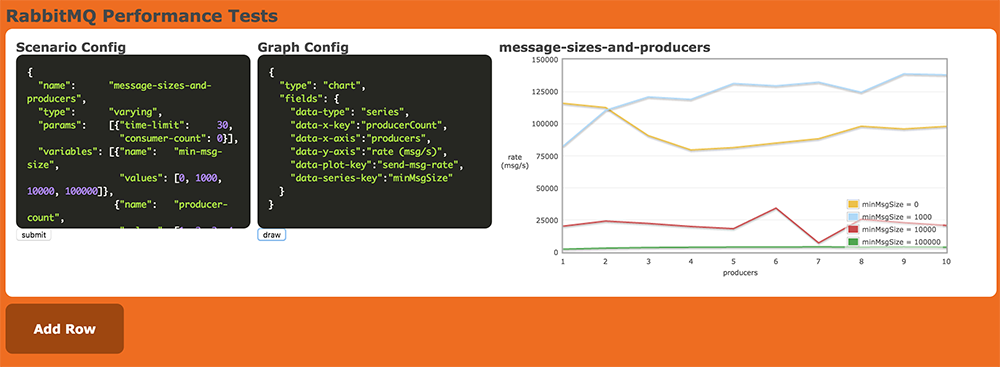RabbitMQ Performance App
A simple way to test the performance of your RabbitMQ Service
This project uses the RabbitMQ Performance Testing Tool to run benchmarks and to graph the results. I created a simple spring app that gives you an easy way to run benchmarks and graph results from the convenience of your browser!
Run the Web App Server
Docker
docker pull johnlonganecker/rmq-perf-app
docker run -p 8080:8080 johnlonganecker/rmq-perf-app
Command Line
Download latest release
java -jar rmq-perf-app.jar
Cloud Foundry
cf push
cf bind-service rabbitmq-perf-app rmq-service
cf restage rabbitmq-perf-app
Releases
Download from the releases page
Compile and Package
Have Maven and Java Installed
mvn install
mvn package
Take it out for a spin
If you don't have a rabbitmq service running you can run one with docker
docker pull rabbitmq
docker run -d -p 5672:5672 rabbitmq
Run the RabbitMQ Performance App
java -jar rmq-perf-app.jar
The server will use rabbitmq's default URI to connect to the docker container. If you need to set your own URI read below.
You can find the WebApp at localhost:8080
Enter a performance Scenario config and how you want to graph it by setting the Graph Config
You can find the documentation for both scenarios and graphs from this repo
Example Configs
Scenario
{
"name": "no-ack",
"type": "simple",
"params": [{"time-limit": 10}]
}
Graph
{
"type": "chart",
"fields": {
"data-type":"time",
"data-x-axis":"time (s)",
}
}
{
"type": "small-chart",
"fields": {
"data-type":"time",
"data-x-axis":"time (s)",
}
}
{
"type": "summary",
"fields": {}
}
Scenario
{
"name": "message-sizes-and-producers",
"type": "varying",
"params": [{"time-limit": 30,
"consumer-count": 0}],
"variables": [{"name": "min-msg-size",
"values": [0, 1000, 10000, 100000]},
{"name": "producer-count",
"values": [1, 2, 3, 4, 5, 6, 7, 8, 9, 10]}]
}
Graph
{
"type": "chart",
"fields": {
"data-type": "series",
"data-x-key":"producerCount",
"data-x-axis":"producers",
"data-y-axis":"rate (msg/s)",
"data-plot-key":"send-msg-rate",
"data-series-key":"minMsgSize"
}
}
Scenario
{
"name": "message-sizes-large",
"type": "varying",
"params": [{"time-limit": 30}],
"variables": [{"name": "min-msg-size",
"values": [5000, 10000, 50000, 100000, 500000, 1000000]}]
}
Graph
{
"type": "chart",
"fields": {
"data-type": "x-y",
"data-x-key":"minMsgSize",
"data-plot-keys":"send-msg-rate send-bytes-rate",
"data-x-axis":"message size (bytes)",
"data-y-axis":"rate (msg/s)",
"data-y-axis2":"rate (bytes/s)",
"data-legend":"ne"
}
}
Scenario
{
"name": "rate-vs-latency",
"type": "rate-vs-latency",
"params": [{"time-limit": 30}]
}
Graph
{
"type": "chart",
"fields": {
"data-type":"r-l",
"data-x-axis":"rate attempted (msg/s)",
"data-y-axis":"rate (msg/s)"
}
}
Where do the host/user/pass/vhost get set?
In the scenario config you can specify a uri like this:
"uri": "amqp://user:password@host:port/vhost"
Cloud Foudry
If you bind a rabbitmq service (based on pivotal's rabbitmq release) to this app it will automatically get the credentials it needs to interact with rabbitmq.
You can of course override those credentials by adding the uri field to the scenario config
Defaults
If no credentials are provided this app will use a default rabbitmq uri to connect to the service
Report Bugs or Feature Requests
Submit a github issue
Contribute
Feel free to do something cool or grab something from the Todo list and just submit a Pull Request :)
ToDo
- Make a bunch of useful examples
- when creating new row have dialog box with pre-made exampels
- examples endpoint (list examples for dialog box)
- Make http server ports configurable through CLI
- unit/smoke/integration tests
- web app
- spring server
- Better Errors
- UI Display
- Messages from server
- Store results
- export results
- import results
- save results to PG/MySQL/other DB
- store info of system with results?
- number of nodes
- policy
- hostname (not full uri)
